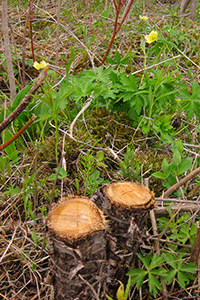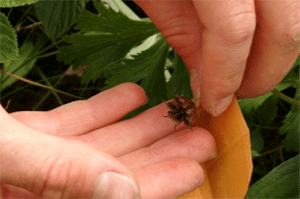Plant Conservation
Overview
Cornell Botanic Gardens endeavors to preserve our region’s natural heritage by helping conserve some of the rarest members of our flora. That conservation work includes efforts that are both in situ (on site) as well as ex situ (outside of its natural habitat).  One of our region’s rarest species, the American Globeflower (Trollius laxus ssp. laxus) can be found in two of Cornell Botanic Gardens' 44 protected natural areas. The American globeflower is an herbaceous perennial that grows in open fens and swamp margins with moderate to highly alkaline groundwater seepage. The 40 populations known worldwide are located in four northeastern states, with more than half of those populations found within a single watershed of Cayuga Lake in the Ithaca area of central New York.
One of our region’s rarest species, the American Globeflower (Trollius laxus ssp. laxus) can be found in two of Cornell Botanic Gardens' 44 protected natural areas. The American globeflower is an herbaceous perennial that grows in open fens and swamp margins with moderate to highly alkaline groundwater seepage. The 40 populations known worldwide are located in four northeastern states, with more than half of those populations found within a single watershed of Cayuga Lake in the Ithaca area of central New York.
In Situ Conservation
Effectively conserving these two populations requires multi-faceted stewardship approaches.
Population Census 
Annual censuses are conducted to track population changes and assess overall health.
(shown right: Annual census data recorded for two locations from 2008 - 2016)
Habitat Management Staff and volunteers control woody invasive species like common buckthorn (Rhamnus cathartica), that alter soil chemistry and compete for light and water. Other management programs to reduce impacts from the overpopulation of white-tailed deer or minimize flooding from beaver activities are also essential and ongoing. Research to help determine optimal light levels for this partial-shade loving plant is also underway.
Staff and volunteers control woody invasive species like common buckthorn (Rhamnus cathartica), that alter soil chemistry and compete for light and water. Other management programs to reduce impacts from the overpopulation of white-tailed deer or minimize flooding from beaver activities are also essential and ongoing. Research to help determine optimal light levels for this partial-shade loving plant is also underway.
(Shown left: American globeflower plants thrive after cutting the invasive common buckthorn and treating the stumps with herbicide).
Augmentation
For small populations, conservation strategies can include augmentation to increase the population numbers. Since 2010, Cornell Botanic Gardens staff have been collecting small amounts of globeflower seed (less than 10% from any individual plant) from multiple maternal (i.e. genetic) lines as part of an augmentation program. Through an informed trial and error process, staff developed effective protocols for propagating globeflower plants, including procedures on seed storage, stratification, and germination requirements, planting mediums, overwintering care, watering regimes and quality and light requirements. These protocols have yielded over 60% seed germination success, and hundreds of plants grown in our production facilities.  At two years of age, Trollius plants are then planted out in the fall to appropriate habitat and monitored. Globeflower survival and vigor data (size and reproduction) is compared to environmental information, including local hydrologic conditions, canopy cover and surrounding vegetation, to help determine appropriate micro-habitat requirements for planting locations. Collectively, these approaches have resulted in over 250 individuals successfully planted out to appropriate habitats with a 98% survival rate to date.
At two years of age, Trollius plants are then planted out in the fall to appropriate habitat and monitored. Globeflower survival and vigor data (size and reproduction) is compared to environmental information, including local hydrologic conditions, canopy cover and surrounding vegetation, to help determine appropriate micro-habitat requirements for planting locations. Collectively, these approaches have resulted in over 250 individuals successfully planted out to appropriate habitats with a 98% survival rate to date.
Ex Situ Conservation
While protecting and managing existing populations is essential, ex situ conservation helps to hedge bets against threats. Whether it may be damage from a natural disaster, loss of pollinators, low genetic diversity, habitat destruction or a changing climate, preserving the genetic diversity of populations though ex situ conservation efforts is a good insurance policy. Through our partnership with the Center for Plant Conservation (CPC), Cornell Botanic Gardens has agreed to lead the conservation efforts for the American Globeflower in the CPC’s National Collection. The National Collection of Endangered Plants is composed of the most imperiled plants in the country. An important conservation resource, the Collection is a backup in case a species becomes extinct or no longer reproduces in the wild. Live plant material is collected from nature under controlled conditions and then carefully maintained as seed, rooted cuttings or mature plants. To date, Cornell Botanic Gardens has helped collect and preserve nearly 7,000 seeds from 300 individual plants across four populations to help safeguard this species and its genetic diversity.
Through our partnership with the Center for Plant Conservation (CPC), Cornell Botanic Gardens has agreed to lead the conservation efforts for the American Globeflower in the CPC’s National Collection. The National Collection of Endangered Plants is composed of the most imperiled plants in the country. An important conservation resource, the Collection is a backup in case a species becomes extinct or no longer reproduces in the wild. Live plant material is collected from nature under controlled conditions and then carefully maintained as seed, rooted cuttings or mature plants. To date, Cornell Botanic Gardens has helped collect and preserve nearly 7,000 seeds from 300 individual plants across four populations to help safeguard this species and its genetic diversity.





